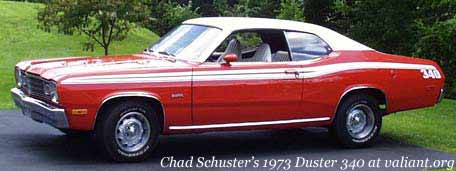The Plymouth Valiant and the Cars Based On It
 The Plymouth (and just plain) Valiant, Dart, Duster, Demon, Swinger, Scamp, and early Barracudas were all deemed “A-bodies.” Production engines ranged from a 170 slant six to a high-performance 383 V-8 (or a Hemi 265); a limited number of 440-powered cars were also available for racing. Outside the US, the Valiant was a luxury car, a high performance Hemi Six-Pack speedster, a utility van, and more, with names like Charger, 3700GT, and even LeBaron.
The Plymouth (and just plain) Valiant, Dart, Duster, Demon, Swinger, Scamp, and early Barracudas were all deemed “A-bodies.” Production engines ranged from a 170 slant six to a high-performance 383 V-8 (or a Hemi 265); a limited number of 440-powered cars were also available for racing. Outside the US, the Valiant was a luxury car, a high performance Hemi Six-Pack speedster, a utility van, and more, with names like Charger, 3700GT, and even LeBaron.
The Valiant was introduced in 1959 as a 1960 model; the Dodge Lancer followed shortly, only to be replaced by the similar Dodge Dart, a longer-wheelbase Valiant. Though the Valiant was originally a separate make, as Mike Sealey reported, it quickly became just another Plymouth:
Prior to the 1960 model year, virtually all U. S. Chrysler Corporation dealers sold Plymouths as a companion make to Chryslers, DeSotos, or Dodges. Plymouth lost the U. S. Dodge dealers with the 1960 introduction of the Plymouth-based (full-size) Dodge Dart. This resulted in a loss of sales, which dropped Plymouth out of its traditional 3rd place in U. S. sales standings. The decision was made to prop up Plymouth sales by including Valiants in the totals. (Valiants were sold in the States by Plymouth dealers, leaving Dodge without a comparable car until the '61 Lancer.)

Mike Sealey and Jeff Chong wrote that there was a 1965 Dart produced in small numbers with the "Charger 273" name. 180 were actually made at the LA factory, and 300 kits were dealer-installed. It was based on a Dart GT either as a hardtop or convertible and all of them were yellow with a black top and interior, with the Hi-Po 273, 13X6 Cragar mag wheels, and special Charger emblems.
 The Valiant's strengths include light weight, durable powertrains, good form, and upgradability. They could seat six people (five comfortably), and often had washable vinyl bench seats. Their automatic transmissions could, with 150,000 miles, could be shifted into reverse at 30 miles per hour with no apparent ill effects other than screeching rear tires, though this is not recommended.
The Valiant's strengths include light weight, durable powertrains, good form, and upgradability. They could seat six people (five comfortably), and often had washable vinyl bench seats. Their automatic transmissions could, with 150,000 miles, could be shifted into reverse at 30 miles per hour with no apparent ill effects other than screeching rear tires, though this is not recommended.
Valiants had electronic ignition long before non-Chrysler cars: it was available in 1972, and was standard by 1973. Chrysler's electronic ignition was exceptionally reliable; the only component likely to break down was the ballast resistor, which costs about $3 and takes about a minute to replace.
The Scamp and Swinger were two-door hardtop versions of the basic Valiant, and retained its angular styling. The far more successful Duster, and its derivatives (the Demon and Twister), used a Valiant front with a completely new rounded rear that provided better aerodynamics and more trunk space.
In Australia, the Valiant spawned the Pacer, Charger, Ute, Panel Van, and Drifter. Some of these had a unique line of Australian straight-six engines. In Europe and South America, the Dodge 3700GT helped to bring more Chrysler sales using a Valiant body with upscale fittings.
The A body platform was used for early Barracudas, and was the basis for the Volare/Aspen, which was, in turn, the basis for the M-bodies, whose rear styling harked back to the 1970s Valiants.


 Your Privacy Choices
Your Privacy Choices